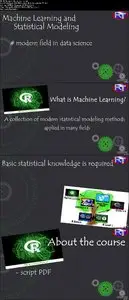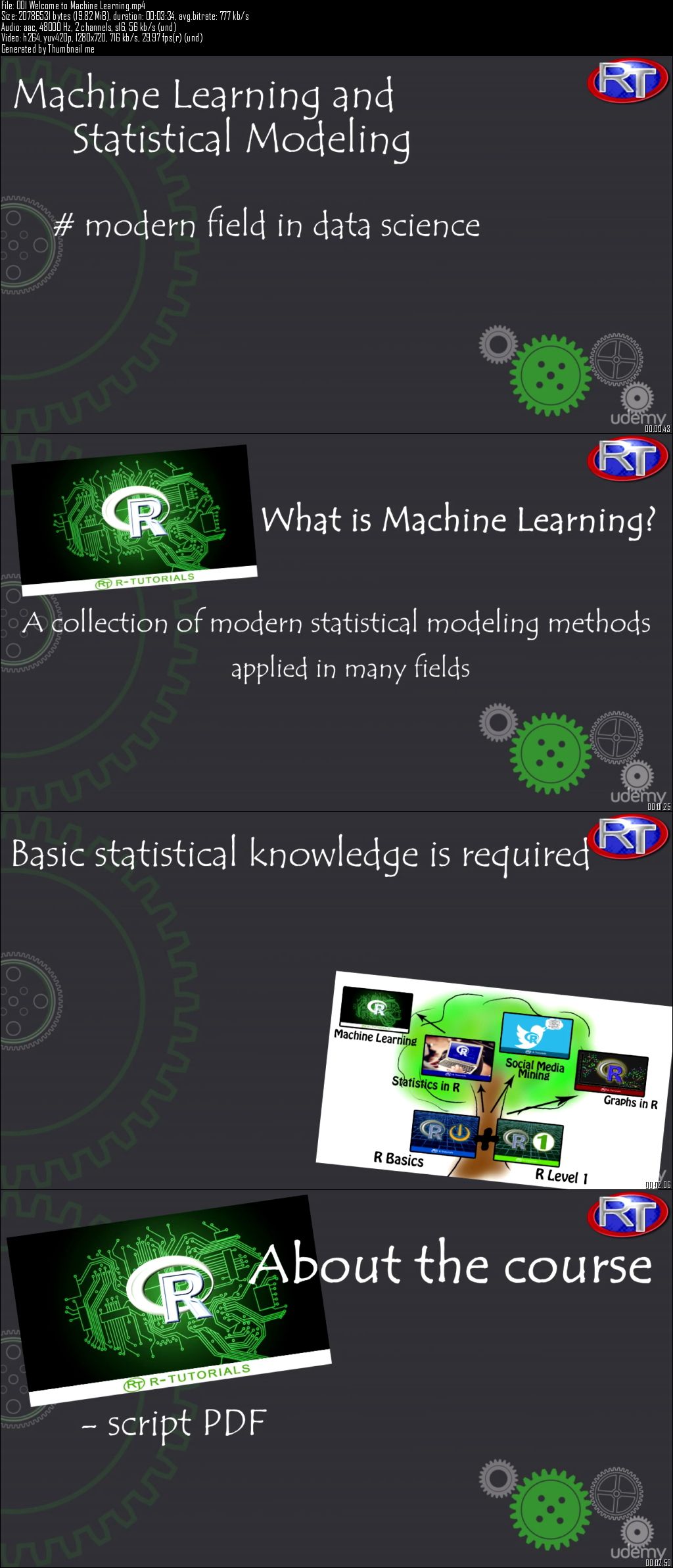Udemy - Machine Learning and Statistical Modeling with R Examples
MP4 | Video: 1280x720 | 56 kbps | 48 KHz | Duration: 3 Hours | 531 MB
Genre: eLearning | Language: English
MP4 | Video: 1280x720 | 56 kbps | 48 KHz | Duration: 3 Hours | 531 MB
Genre: eLearning | Language: English
Learn how to use machine learning algorithms and statistical modeling for clustering, decision trees, etc by using R
See things in your data that no one else can see – and make the right decisions!
Due to modern technology and the internet, the amount of available data grows substantially from day to day. Successful companies know that. And they also know that seeing the patterns in the data gives them an edge on increasingly competitive markets. Proper understanding and training in Machine Learning and Statistical Modeling will give you the power to identify those patterns. This can make you an invaluable asset for your company/institution and can boost your career!
Marketing companies use Machine Learning to identify potential customers and how to best present products.
Scientists use Machine Learning to capture new insights in nearly any given field ranging from psychology to physics and computer sciences.
IT companies use Machine Learning to create new search tools or cutting edge mobile apps.
Insurance companies, banks and investment funds use Machine Learning to make the right financial decisions or even use it for algorithmic trading.
Consulting companies use Machine Learning to help their customers on decision making.
Artificial intelligence would not be possible without those modeling tools.
Basically we already live in a world that is heavily influenced by Machine Learning algorithms.
1. But what exactly is Machine Learning?
Machine learning is a collection of modern statistical methods for various applications. Those methods have one thing in common: they try to create a model based on underlying (training) data to predict outcomes on new data you feed into the model. A test dataset is used to see how accurate the model works. Basically Machine learning is the same as Statistical Modeling.
2. Is it hard to understand and learn those methods?
Unfortunately the learning materials about Machine Learning tend to be quite technical and need tons of prior knowledge to be understood.
With this course it is my main goal to make understanding those tools as intuitive and simple as possible.
While you need some knowledge in statistics and statistical programming, the course is meant for people without a major in a quantitative field like math or statistics. Basically anybody dealing with data on a regular basis can benefit from this course.
3. How is the course structured?
For a better learning success, each section has a theory part, a practice part where I will show you an example in R and at last every section is enforced with exercises. You can download the code pdf of every section to try the presented code on your own.
4. So how do I prepare best to benefit from that course?
It depends on your prior knowledge. But as a rule of thumb you should know how to handle standard tasks in R (courses R Basics and R Level 1). You should also know the basics of modeling and statistics and how to implement that in R (Statistics in R course).
For special offers and combinations just check out the r-tutorials webpage which you can find below the instructor profile.
What R you waiting for?
IT companies use Machine Learning to create new search tools or cutting edge mobile apps.
Insurance companies, banks and investment funds use Machine Learning to make the right financial decisions or even use it for algorithmic trading.
Consulting companies use Machine Learning to help their customers on decision making.
Artificial intelligence would not be possible without those modeling tools.
Basically we already live in a world that is heavily influenced by Machine Learning algorithms.
1. But what exactly is Machine Learning?
Machine learning is a collection of modern statistical methods for various applications. Those methods have one thing in common: they try to create a model based on underlying (training) data to predict outcomes on new data you feed into the model. A test dataset is used to see how accurate the model works. Basically Machine learning is the same as Statistical Modeling.
2. Is it hard to understand and learn those methods?
Unfortunately the learning materials about Machine Learning tend to be quite technical and need tons of prior knowledge to be understood.
With this course it is my main goal to make understanding those tools as intuitive and simple as possible.
While you need some knowledge in statistics and statistical programming, the course is meant for people without a major in a quantitative field like math or statistics. Basically anybody dealing with data on a regular basis can benefit from this course.
3. How is the course structured?
For a better learning success, each section has a theory part, a practice part where I will show you an example in R and at last every section is enforced with exercises. You can download the code pdf of every section to try the presented code on your own.
4. So how do I prepare best to benefit from that course?
It depends on your prior knowledge. But as a rule of thumb you should know how to handle standard tasks in R (courses R Basics and R Level 1). You should also know the basics of modeling and statistics and how to implement that in R (Statistics in R course).
For special offers and combinations just check out the r-tutorials webpage which you can find below the instructor profile.
What R you waiting for?





